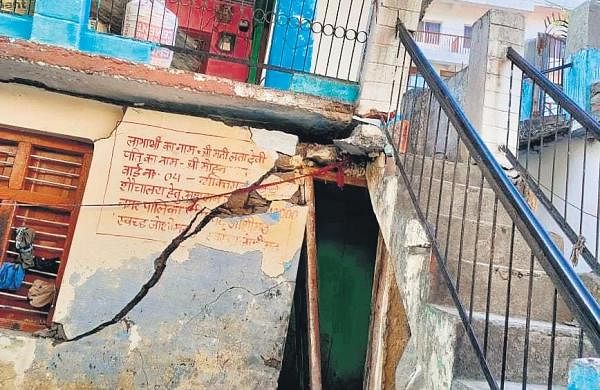Express News Service
DEHRADUN: Joshimath’s land sinking continues unabated. Worse, the old cracks have only widened and new ones have developed at the same places. In the latest cases, the Central Building Research Institute (CBRI), which is monitoring the situation, has found that the gaps in old cracks have increased again. Based on the information received by CBRI, there have been cases of new cracks and widening of old cracks.
Speaking to TNIE, SDM Joshimath Kumkum Joshi confirmed that the cracks had become slightly wider. “The new cracks are at the same places where cases of land submergence were reported earlier. These include the disaster-hit areas of Gandhinagar, Singhdhar and Marwari, where the land rapidly submerged earlier this year.”
“After inspection, the CBRI team reported minor cracks around the old ones, which had developed in the previous incident of land submergence earlier this year. The newly affected houses were earlier considered under the ‘green zone’ by the CBRI, which means that the subsidence-affected houses are safe as per as the norms of an expert committee,” said the SDM.
Residents of the affected houses said the recent rains made the situation worse. The residents have sought the intervention of the district administration, citing constant fear in the broken buildings. “Many residential and commercial buildings in Joshimath developed cracks due to land being submerged, resulting in a large number of people being shifted to safer buildings,” SDM Kumkum Joshi said. “Commercial buildings that developed cracks also had to be demolished.” The State Disaster Management Authority said that 863 buildings had developed cracks.
Based on the report submitted by an expert committee headed by the National Disaster Management Authority (NDMA), the state government sought a relief package of Rs 2,943 crore from the Centre, on which the Central government is yet to decide.
DEHRADUN: Joshimath’s land sinking continues unabated. Worse, the old cracks have only widened and new ones have developed at the same places. In the latest cases, the Central Building Research Institute (CBRI), which is monitoring the situation, has found that the gaps in old cracks have increased again. Based on the information received by CBRI, there have been cases of new cracks and widening of old cracks.
Speaking to TNIE, SDM Joshimath Kumkum Joshi confirmed that the cracks had become slightly wider. “The new cracks are at the same places where cases of land submergence were reported earlier. These include the disaster-hit areas of Gandhinagar, Singhdhar and Marwari, where the land rapidly submerged earlier this year.”
“After inspection, the CBRI team reported minor cracks around the old ones, which had developed in the previous incident of land submergence earlier this year. The newly affected houses were earlier considered under the ‘green zone’ by the CBRI, which means that the subsidence-affected houses are safe as per as the norms of an expert committee,” said the SDM.googletag.cmd.push(function() {googletag.display(‘div-gpt-ad-8052921-2’); });
Residents of the affected houses said the recent rains made the situation worse. The residents have sought the intervention of the district administration, citing constant fear in the broken buildings. “Many residential and commercial buildings in Joshimath developed cracks due to land being submerged, resulting in a large number of people being shifted to safer buildings,” SDM Kumkum Joshi said. “Commercial buildings that developed cracks also had to be demolished.” The State Disaster Management Authority said that 863 buildings had developed cracks.
Based on the report submitted by an expert committee headed by the National Disaster Management Authority (NDMA), the state government sought a relief package of Rs 2,943 crore from the Centre, on which the Central government is yet to decide.





